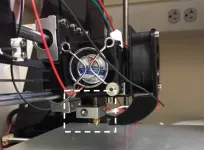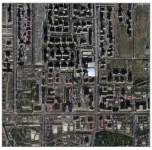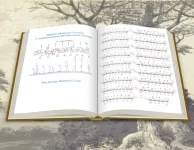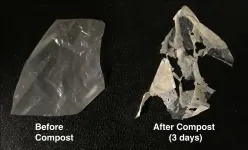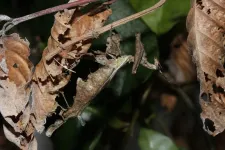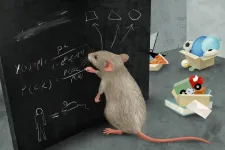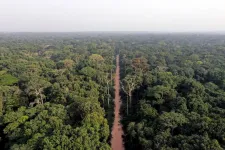(Press-News.org) BUFFALO, N.Y. - 3D printing is transforming everything from fashion and health care to transportation and toys. But this rapidly evolving technology, also known as additive manufacturing, can threaten national security and intellectual property rights.
To reduce illicit use of 3D printers, Zhanpeng Jin, PhD, associate professor in the Department of Computer Science and Engineering at the University at Buffalo, is developing a way to track the origin of 3D-printed items.
His concern was that, as long as people have the digital design for an item, which can be downloaded from the internet, sometimes as open-source material, people can print out anything they want, which can range from computer parts and toys to fully functional handguns and assault rifles.
"So, what would be the best way to protect our intellectual property from someone else printing the same design using their own printer?" says Jin. "We wanted to find something internal. What would be the inherent signatures printed by my own 3D printer instead of another 3D printer?"
3D printers build three-dimensional objects by adding successive layers of printing materials according to the digital design for a 3D model. Each 3D printer has an "extruder," which pushes the building material along. The extruder's hot end then melts the material, and places it on the print bed to build the model.
In a paper, "ThermoTag: A Hidden ID of 3D Printers for Fingerprinting and Watermarking," published in the journal IEEE Transactions on Information Forensics and Security, a research team led by Jin describes how each extruder's hot end has its own unique heating properties, which impact the precise way that the 3D model is constructed.
Those thermodynamic properties can be used to identify the specific extruder and, thus, the model of 3D printer, as uniquely as a human fingerprint, or, as Jin calls it, a "ThermoTag."
Jin compared the process to using a laptop to write a letter. Because software exists that can track keystrokes, an observer can see every step that went into the letter, including the writer's unique writing style. Similarly, because of the unique properties of each 3D printer's extruder, a researcher can examine the specific manner in which a 3D-printed object was made, and compare that to a database of various extruders until a match is made. From there, once the model printer is identified, the purchaser of said model can be tracked down if they had, say, used the printer to build an illegal assault rifle.
According to the research, Jin and his team discovered that, by examining and comparing the ThermoTag features of 45 different extruders of the same model, they were able to correctly identify the source printer with an accuracy rate of 92%.
"This ThermoTag will behave like the fingerprint of the 3D printer. When you print out a new product, you can use watermarking," Jin says, noting that watermarking can be used to invisibly embed such information as the printer's manufacturer, label and serial number in the product. "So that would make this watermark of this particular product unique."
It's possible, Jin says, that someone could replace their extruder to try to avoid detection. That's why it's important to create a database of these parts for comparison, he says.
INFORMATION:
Co-authors of the study are UB faculty members Chi Zhou, PhD, associate professor in the Department of Industrial and Systems Engineering, and Wenyao Xu, PhD, associate professor in the Department of Computer Science and Engineering. The lead student author is Yang Gao, and additional student co-authors include Wei Wang and Yincheng Jin, all graduate students in Jin's lab.
A fire in Central Park seems to appear as a smoke plume and a line of flames in a satellite image. Colorful lights on Diwali night in India, seen from space, seem to show widespread fireworks activity.
Both images exemplify what a new University of Washington-led study calls "location spoofing." The photos -- created by different people, for different purposes -- are fake but look like genuine images of real places. And with the more sophisticated AI technologies available today, researchers warn that such "deepfake geography" could become a growing problem.
So, using satellite photos of ...
BIRMINGHAM, Ala. - Treatment of an injured or diseased joint may require precise insertion of a syringe needle -- musculoskeletal sonography can help guide clinicians as they drain fluid from arthritic knees or inject corticosteroids into trigger fingers. However, there is a need for training simulators that allow practice on an inert model, before attempting treatment on a patient.
For ultrasound, such simulation trainers are called phantoms.
Researchers at the University of Alabama at Birmingham and University of South Carolina have now made a 3D-printed ...
Decades-old aerial photos of Yudong District, Datong City in Shanxi Province, Northern China have helped researchers in their search for a fault hidden underneath the city's buildings and cement roads, researchers said at the Seismological Society of America (SSA)'s 2021 Annual Meeting.
Analyzing these photos from the 1960s and 1970s allowed Junjie Ren and colleagues to reconstruct a digital elevation model along the Shuiyu fault, helping them identify the fault trace as it passes through Datong City.
Trenching along the revealed fault trace found evidence of ...
Concrete efforts to bring racial equity to the geosciences are receiving significant attention in the wake of new grassroots efforts and increased awareness of social justice issues in 2020, speakers said at the Seismological Society of America (SSA)'s 2021 Annual Meeting.
Last year's Black in Geoscience Week, for instance, began as a grassroots movement to increase representation and raise visibility among Black researchers, as well as to foster networks and connections across the world, said Louisa Brotherson, a leader of the Black in Geoscience group.
The need for community and awareness ...
Ever wondered why your virtual home assistant doesn't understand your questions? Or why your navigation app took you on the side street instead of the highway? In a study published April 21st in the journal iScience, Italian researchers designed a robot that "thinks out loud" so that users can hear its thought process and better understand the robot's motivations and decisions.
"If you were able to hear what the robots are thinking, then the robot might be more trustworthy," says co-author Antonio Chella, describing first author Arianna Pipitone's idea that launched the study at the University of Palermo. "The robots will be easier to understand for ...
Using a novel molecular-data-storage technique, researchers at the University of Texas at Austin have encoded a quote from Jane Austen's classic novel Mansfield Park in a series of oligomers, which a third party could read back without prior knowledge of the structures that encoded the passage. The findings, published April 21st in the journal Cell Reports Physical Science, illustrate a method to encode data that allows for greater information density than DNA-based approaches and that relies on urethane-like plastics--highly accessible and structurally modifiable chemical feedstocks--instead of nucleic acids.
"This work is another step toward the long-term goal of using synthetic sequence-defined polymers for information storage," says Eric Anslyn, a chemistry ...
Biodegradable plastics have been advertised as one solution to the plastic pollution problem bedeviling the world, but today's "compostable" plastic bags, utensils and cup lids don't break down during typical composting and contaminate other recyclable plastics, creating headaches for recyclers. Most compostable plastics, made primarily of the polyester known as polylactic acid, or PLA, end up in landfills and last as long as forever plastics.
University of California, Berkeley, scientists have now invented a way to make these compostable plastics break down more easily, with just heat and water, within a few weeks, solving a problem that has flummoxed the plastics industry and environmentalists.
"People are now prepared to move into biodegradable polymers for single-use ...
It isn't only myriads of currently unknown species that await discovery in the Amazon rainforests. As a new study by German scientists at the Ruhr-University (Bochum) and the Bavarian State Collection of Zoology (Munich), published in the open-access peer-reviewed scientific Journal of Orthoptera Research, concludes, it seems that so do plenty of unusual behaviours.
"When I saw the maggot-like structures peeking out from the back of the praying mantis and then withdrew, I immediately thought of parasites that eat the animal from the inside, because that is not really uncommon in insects," says Frank Glaw, a reptile and amphibian expert from the Bavarian State Collection of Zoology, who discovered ...
Categorization is the brain's tool to organize nearly everything we encounter in our daily lives. Grouping information into categories simplifies our complex world and helps us to react quickly and effectively to new experiences. Scientists at the Max Planck Institute of Neurobiology have now shown that also mice categorize surprisingly well. The researchers identified neurons encoding learned categories and thereby demonstrated how abstract information is represented at the neuronal level.
A toddler is looking at a new picture book. Suddenly it points to an illustration and shouts 'chair'. The kid made the right call, but that does not seem particularly noteworthy to us. We recognize all kinds of chairs as 'chair' without any difficulty. ...
Central Africa is home to the world's second-largest area of dense tropical rainforest. This major reservoir of biodiversity stretches out over five main countries: Cameroon, Gabon, the Republic of Congo, the Democratic Republic of Congo and the Central African Republic. It provides numerous ecosystem services, such as regulating exchange cycles between the earth and the atmosphere, and helps to ensure food supply for local populations. Due to the threats from climate change and demographic pressure expected in Africa by the end of the 21st century, the protection and sustainable management of these forests is a challenge for policy ...
